Today we travel to a future where fisheries collapse, and we turn the ocean into a giant farm.
Guests:
- Amanda Nickson: director of international fisheries at The Pew Charitable Trusts
- Daniel Pauly: professor University of British Columbia, principal investigator at Sea Around Us, author of Vanishing Fish: Shifting Baselines and the Future of Global Fisheries
- Bernard Friedman: founder of Santa Barbara Mariculture
- Tyler Sclodnick: senior scientist, InnovaSea Systems Inc.
- Patricia Majluf: vice president, Peru of Oceana
Further Reading:
- The future of fish
- Marine defaunation: Animal loss in the global ocean
- Pacific Bluefin Tuna Stock Remains Highly Depleted, New Science Shows
- Vanishing Fish: Shifting Baselines and the Future of Global Fisheries
- Devoted to Keeping Lobster Divers of Honduras Alive
- Archaeologists land world’s oldest fish hook
- UN Fisheries Report
- Daniel Pauly TED Talk: The ocean’s shifting baseline
- Impacts of Biodiversity Loss on Ocean Ecosystem Services
- Ethical Issues in Aquaculture Production
- Aquaculture environment interactions: Past, present and likely future trends
- Accelerated modern human–induced species losses: Entering the sixth mass extinction
- Mariculture: A global analysis of production trends since 1950
- InnovaSea Mariculture
- China’s aquaculture and the world’s wild fisheries
- Perceptions of wilderness and their application to ocean and coastal waters
- The Last Call for Marine Wilderness?
- ‘‘I know it when I see it’’: Identifying ocean wilderness using a photo-based survey approach
Actors:
- The Snowglobe Narrator: Brent Rose
- Lenny Haywood: Evan Johnson
- Farah Mousterian: Zahra Noorbakhsh, host of Good Muslim, Bad Muslim
- John Jacob Siwa: Joseph Jones
- Juana Aguilar: Tamara Krinsky
- Christina Amity: Angeli R. Fitch
Sponsored by PNAS Science Sessions: Subscribe on iTunes today
Flash Forward is produced by me, Rose Eveleth. The intro music is by Asura and the outtro music is by Hussalonia. The episode art is by Matt Lubchansky. Special thanks this episode to the Women Audio Mission studios, Maryam Qudus, Stephanie Lopez, The Potluck Podcast studio, the Potluck Podcast Collective and Quincy Surasmith.
If you want to suggest a future we should take on, send us a note on Twitter, Facebook or by email at info@flashforwardpod.com. We love hearing your ideas! And if you think you’ve spotted one of the little references I’ve hidden in the episode, email us there too. If you’re right, I’ll send you something cool.
And if you want to support the show, there are a few ways you can do that too! Head to www.flashforwardpod.com/support for more about how to give. But if that’s not in the cards for you, you can head to iTunes and leave us a nice review or just tell your friends about us. Those things really do help.
That’s all for this future, come back next time and we’ll travel to a new one.
FULL TRANSCRIPT BELOW
▹▹ ▹▹ ▹▹ ▹▹ ▹▹ ▹▹ ▹▹ ▹▹ ▹▹ ▹▹ ▹▹ ▹▹ ▹▹ ▹▹ ▹▹ ▹▹ ▹▹ ▹▹ ▹▹ ▹▹ ▹▹ ▹▹ ▹▹
Rose: Hello and welcome to Flash Forward! I’m Rose and I’m your host, and this is the last episode of our Earth miniseason. If this is the first episode of Flash Forward you’ve ever listened to, here’s the deal: Flash Forward is a show about the future. Every episode I take you to a new future. Some of them are possible. Some of them… not so much! First we take a little field trip to tomorrow, to see what’s going on, and then we teleport back to today to hear from real experts about how that future we just saw might really go down. Got it? Great!
Thanks to PNAS Science Sessions for supporting Flash Forward. Today, take five minutes and learn something new about the physical, social, and natural worlds from the frontiers of science. Subscribe to Science Sessions on iTunes, Spotify, Google Play, Stitchr, or wherever you get your podcasts.
Okay, let’s go to the future. Today we’re starting in the year 2062.
[music up]
Narrator: Everybody thinks they’re on the verge of the next million dollar idea. But do they have what it takes to really make it big? It’s time to find out. Real entrepreneurs. Real investors. Real success. But don’t expect anything warm and fuzzy. Welcome to THE SNOWGLOBE. Let’s meet the bears.
Lenny Haywood: Doesn’t matter if the glass is half-empty or half-full. All that matters is that you are the one pouring the water.
Narrator: Farah Mousterian: the daughter of Syrian immigrants who went on to become a technology mogul like the world has never seen, selling her first startup for 4 billion at the age of 15 and never slowing down.
Farah: Mousterian: I love dreamers, dreams are great, but without a business plan, a dream can turn into a nightmare. My advice is always: Follow the green, not the dream.
Narrator: John Jacob Siwa, a fashion icon turned fashion mogul who doesn’t just walk the runway, he owns it, literally.
John Jacob Siwa: I’m not a tough guy. I’m just delivering the truth and only the truth and if you can’t deal with it, you can’t deal with my money either.
Narrator: And Juana Aguilar, a venture capitalist who has taken hundreds of businesses under her wing to form the world’s largest and most profitable corporation conglomerate worth nearly a trillion dollars.
Juana Aguilar: Everybody thinks they have great ideas, your dumb cousin thinks he’s invented the best mousetrap in the world. And maybe he has! The question is whether he can make that idea into something real.
Narrator: The bears will hear from the world’s best, brightest and savviest inventors. For some, it will be heartbreaking
Roberta: It’s not paranoia, it’s science!
Lenny: Are you kidding me?
John: She’s trying to rip you off!
Amy: Can you give me a second to think, please?
Farah: Oh my god we’re all going to die.
Narrator: For others, it will turn into the opportunity of a lifetime.
John: These are nice!
Kevin: This is the future of building ladies and gentlemen!
Christina: Who wants to dive in, the water’s empty!
Farah: We’re going to make some money before society collapses girls!
Let’s step into the globe. [[whoosh]]
[footsteps]
Christina Amity: [forceful] The ocean is dead and it’s time to move on. I know it sounds harsh, but hear me out. Just like you I grew up loving those stories about whales and dolphins, hearing about how the oceans used to be teeming with life. But for the past 15 years countless countries and agencies have tried to revive ocean habitats and they’ve had no success. It’s time to reclaim the oceans on our terms, and take advantage of the vast amount of space they provide.
I’m Christina Amity, and I’m the founder of SHORA, a set of networked products for the future of open ocean agriculture.
The open ocean is an immense, basically untapped region ripe for agricultural development. And right now there are hundreds of companies looking to spin up farms in that open water — harvesting everything from kelp to oysters to more traditional fish like tuna or sardines. And what every single one of those companies is going to need, is autonomous equipment to maintain those farms. And that, is what SHORA offers.
I’ve invented a line of products that make SHORA a one stop shop for every new ocean farm. From cameras to keep track of your growth and fish, to autonomous cleaning devices for nets, to sensors that monitor growth and nutrient levels.
We’ve got products that work for almost any sized application — from a small family ocean farm, to the biggest kelp setup you can possibly imagine. And our revenue stream is diverse too. Customers purchase these highly engineered devices once, but they also license the software to use them from us on an annual basis. We’re constantly improving this software, so this is really a great situation for the customers because they’re constantly getting better working equipment.
Lenny: So what are we looking at, here?
Christina: This is live footage from a pilot project off the coast of Maine. So this is coming from a network of these cameras.
Farrah: And you’ve sold this system to people?
Christina: I’ve already got contracts with several land-based farming operations looking to diversify and move into the open ocean space. This is about to be a huge business opportunity. [cheesy] Who wants to dive in, the water’s empty?
Farrah: I’m interested in the software licensing side — so you’re basically replicating the John Deere model here?
Christina: Yes, exactly.
Farrah: And did you develop the software yourself?
Christina: I did yes.
Farrah: Excellent.
Juana: Do you have patents on these?
Christina: I have a patent on the drone and the cleaner device, not the camera.
Juana: Right.
John: [skeptical] So my grandfather was a fisherman. It’s tough work. It’s messy, it’s hard, and it doesn’t make a lot of money.
Christina: It didn’t then because fishermen like your grandfather had to go out and find the fish. These systems are more like farms than like what your grandfather did. Plus, the business model here doesn’t rely on the price of fish or kelp. I’m selling technology, not food.
Lenny: So we’re seeing fish in that pen right? On this camera?
Christina: Haddock, yes.
Lenny: And I guess you don’t have to worry about sharks eating this stuff anymore, because… there aren’t sharks anymore?
Christina: Exactly. The most dangerous thing that can happen to these farms is a biofilm outbreak or a jellyfish bloom. And I’ve got techniques for monitoring and stopping those kinds of things.
Juana: So what happens if the big animals do come back, though.
Christina: I … don’t think that’s likely.
Juana: You think the oceans are just… done for. From an environmental perspective.
Christina: I do.. I mean, look, I’m not happy about it. But at some point you have to admit defeat and see what the silver linings are. I think this is the silver lining here. The United Nations estimates that 915 million people are underfed every year. We’re running out of agricultural land, we need to find new ways to generate food for people to eat. And I think this is part of the solution.
Farrah: So what’s the legal structure in the ocean. You don’t own the water, like you own your land right?
Christina: That’s right the open ocean is governed by the Law of the Sea.
Farrah: So what does that mean for these farms.
Christina: So far nothing, most of the farms we see right now are built in exclusive economic zones within a coastal country’s domain. Plus, farms within an EEZ don’t have to comply with state regulations, so you can avoid some of the annoying farm laws that various states might have.
Farrah: Okay, great, less regulation is always good. But that means that you can only really sell to countries and markets with coastline?
Christina: Yeah, but that’s still a huge market.
Lenny: How huge.
Christina: If you do a bit of back of the envelope calculations — looking at places that have a port nearby to distribute the food and all that, there are currently 89,468 square kilometers that could be used for ocean farming with zero legal problems.
Farrah: Then what — let’s say you exhaust that market. Is the open ocean really accessible for these businesses?
Christina: It’s hard to say. There’s a seabed authority that regulates how seabed mining is operated, but there’s really not much regulating farming in the open ocean.
Juana: Do you think those regulations will come?
Christina: Probably, the UN loves to regulate stuff! But again, I’m selling technology not food. I don’t have to worry about how those farms are regulated, and regardless of what they can and can’t do, they’ll need my technology.
Juana: Not if they’re regulated out of existence they won’t.
Christina: True, but I don’t think that’s likely. The world needs food and the oceans are barren, we have to use that space. It would be stupid not to!
Juana: And how much do these cost?
Christina: Each camera is $450, the cleaning robot is $5,000 and the autonomous patrol drones are $6,000. Most big operations will need more than one of each.
Farrah: And the software license?
Christina: It depends on the scale of the operation, but it ranges from $50 a month to $2,000 a month for the big farms with complex networks.
Juana: And the processing required for these autonomous drones, where is that happening? On shore? Does that get impacted by storms?
Christina: We actually have a network of cubesats dedicated just for SHORA processing. A huge storm could probably impact performance, but you’d have other problems, too, at that point.
Lenny: Okay what are you asking for here?
Christina: $750,000 for 20%
Lenny: I’ll do it.
Christina: [surprised] Oh!
Farrah: Woah woah woah… don’t just accept the first deal you hear. I’ll give you a million for 20%.
Lenny: Come on.
Farrah: I know software licensing, I know tech.
Lenny: I know tech!
John: [laughing] This is going to get ugly.
Lenny: I’ll match her million.
Christina: Would you two be willing to combine your deals…
[simultaneously]
Farrah: No
Lenny: No
Juana: Trust me, you do not want them to try to work together.
Farrah: Christina, listen to me, I have the connections to make this work for you. You need to cut the price of those drones down for this to be viable, and I have a company that manufactures those parts. Your business here is software, not hardware.
Lenny: No, you’re wrong. The key here is political connections — you need to be able to keep the UN from getting in you way here. Farrah doesn’t know anybody at the UN, I do!
Farrah: Oh come on what are you offering to bribe UN officials for her? On national television?
Lenny: No I’m just saying that I know people!
Farrah: You don’t need bribery, you need to refine your business model.
Christina: Can I take a second to think?
Lenny: Don’t take too long.
[pause]
Christina: Okay… Farrah, let’s do it.
Lenny: Come on!
Farrah: Hah! Excellent, Christina we’re going to take over the ocean!
[music up]
Rose: Okay, so today we’re headed to the ocean. And more specifically, we’re considering the future of the stuff we take out of the ocean.
Amanda Nickson: If you think about the Earth, as a whole, about 70 percent of it is ocean.
Rose: This is Amanda Nickson, the director for international fisheries at The Pew Charitable Trusts.
Amanda: So we tend to think of ourselves as, you know, a terrestrial planet with a whole lot of water that has some useful stuff in it. But in fact we are really an ocean planet.
Rose: And humans have been dipping into all those oceans for food and resources for tens of thousands of years. The earliest fish hook archaeologists have ever found comes from East Timor (an island nation near Australia) and dates back to 42,000 years ago. The Food and Agriculture Organization of the United Nations estimates that 170 million tons of fish and seafood were produced in 2016 — that number encompasses freshwater fish, saltwater fish, crustaceans, molluscs and other aquatic animals. And that number, that 170 million tonnes, that includes animals that were caught from the wild, as well as animals that were farmed. And the breakdown between those two categories is about half and half — 90 million tons were caught and 80 million tons were farmed.
We’ll come back to the farming bit later in the show — but first let’s talk about seafood that’s caught in the wild.
Amanda: There are about 2 billion people on the planet who are dependent on fishery resources for either income, or food, or well-being. So when we look at that, and then consider the state of fisheries, things get a little bit worrying.
Rose: Now, you might have heard, probably, that ocean fish aren’t doing so hot. Especially the ones that we eat for food. And in order to understand why, we have to actually go back to the late 19th century.
Daniel Pauly: It started, in my view, when we deployed the first fossil fuel driven trawlers; steam driven trawlers around the UK.
Rose: This is Daniel Pauly, a professor of fisheries at the University of British Columbia, and the head of a program called Sea Around Us. Daniel is also the author of a new book called Vanishing Fish: Shifting Baselines and the Future of Global Fisheries. And he says that when these powerful steam ships came onto the scene in the UK, they kicked off, basically, a fishing gold rush.
Daniel: These were much more powerful than the sail boats that we’re used up to then, and about 10 to 100 times more powerful, ton for ton. And they made a short life of those stocks of fish that were around the British Isles.
Rose: From there, fishing technologies got more and more sophisticated. When World War II ended, a lot of the technologies that were developed during the war were adopted by fishing fleets.
Daniel: Steam was replaced by diesel, and sonar was invented to fight submarine, but to find school of fish.
Amanda: There’s been massive advances in technology, things like radar and refrigeration. And all of that is made it possible to fish vast areas of the ocean very very efficiently and effectively.
Rose: By the 1960’s and 1970’s, humans had gotten really, really good at catching fish. Like… probably too good.
Daniel: Basically, it was a matter of fishing a stock to exhaustion, and then moving on. There was no real sustainability. No attempt to rebuild the stocks that were left behind, but a steady outward expansion.
Rose: And while these fish stocks were hurting, demand for fish was skyrocketing. So fisheries managers worked hard to come up with new methods of fishing.
Daniel: I was participating in the seventies in an attempt, a successful attempt, to introduce trawling in Indonesia. And so the catch continues to increase for a while.
Rose: And when they started running out of fish people would buy, they would try to introduce new fish onto the market by rebranding it.
Daniel: You can catch absolutely horrid fish that you could never sell whole, but you can cut the head off. For example, a monk fish sounds good. But if you still saw them, they’re absolutely revolting. The same for the Slimehead, sold as Orange Roughy. Call it Slimehead, you can see how well it would go. In every in every country fish are renamed to acquire a good name.
In Germany, smoked shark is called Locks of Schiller. You know, Schiller is a German poet who had blonde locks. And shark steaks are called veal of the sea in France.
Rose: You know that fake crab stuff that you get in like California rolls? It’s sometimes called surimi. And… okay so if you want to keep eating that stuff you might want to skip this part because I’m about to tell you how it’s made.
Daniel: It’s the bottom of the barrel that you’re scraping. If you have fish that you cut the filet of the flesh between these bones, and with high pressure hose you can wash this flesh off, and concentrated, and put it in a bottle, and press it, and you get Surimi, this fake crab. It’s actually leftovers. It’s residues.
Rose: So throughout the 20th century, fishermen are coming up with new fish to sell, new ways to package fish, they’re going further out into the ocean, and scraping further down in the ocean, all the way to the bottom sometimes. It was basically a fishing free for all.
Amanda: People really thought the ocean was inexhaustible, there wasn’t too much concern about expanding fishing effort, because there was a sense that it was fundamentally impossible to overfish the ocean. And so, you know you don’t really need any rules or a whole lot of concern about how fishing occurs.
Rose: Well, it turns out it is not impossible to overfish the ocean.
Amanda: And that has led to a situation where about a third of fish stocks globally are overfished. And 60 percent of them are fished to the point where you really can’t take any more out before you’re in the overfished category. So fished to the actual brink of sustainability.
Rose: Right now, everything from sea bass, to salmon, to cod, to halibut, to the lesser known orange roughy, are all in precarious positions due to overfishing.
Amanda: Pacific bluefin is even in a worse situation, it is down 96 per cent from its historic level, and are considered vulnerable to extinction at this stage.
Rose: The sort of frustrating thing here is that… the solution to this problem seems pretty simple.
Amanda: This is a really fixable problem, because all you have to do is not take too much fish out. Fisheries are the single biggest renewable protein resource on the planet, and all we have to do is not take too much out.
Rose: So why has it proven so hard to just… take less? It turns out that there are a couple of reasons. The first is that, for a while, it was hard to convince people that taking too much was the problem. In the 1950’s, for example, when the sardine fishery in California collapsed from all the fishing, people blamed the environment.
Daniel: The same thing happened in the 70s with the Peruvian anchovy, which at the time was the biggest fishery in the world. And it collapsed as well. And it was all blamed on El Nino.
Rose: In other places, people blame seals or whales for eating all the fish — and in fact, there’s a really interesting story there, that we don’t have time for right now about corruption, whaling, and why some whale counting studies are actually funded by people who are pushing the idea that whales have to be killed and harvested because they’re a danger to fish stocks. For more on that, check out the special Patron bonus episode this week. Go to patreon.com/flashforwardpod and sign up at a $5 or more level. Okay, plug over.
Today, it’s pretty well accepted that it’s not El Nino or seals that are threatening the fish in the ocean. It’s us. But even with that knowledge, it can be hard to fix the problem. Scientists can say “here’s how much is a sustainable amount to take out of this fishery” but when the quotas are set by governments … that isn’t always the number they use.
Amanda: even countries like the US, which we would consider to be a reasonably responsible fishing manager, is actually overrunning their quota of an endangered fish population operating internationally.
Rose: The laws and treaties that apply to fishing were all written at a time when people didn’t really think you could overfish. And the decision makers, the ones who actually set these quotas, they’re often politicians who are in power for just a few years.
Amanda: I think the reason that quotas get set higher than the scientific advice is because, if you have an existing short term economic gain that you want to meet, you’re going to try and meet that need.
Rise: And then there’s all the illegal stuff.
Amanda: We also know that, because of the lack of effective rules on policies and enforcement, about one in five fish is caught illegally. Which means that the removal of those fish again puts additional pressure on populations.
Rose: The World Wildlife Foundation estimates that more than 85 percent of global fish stocks are a significant risk of illegal and unreported fishing. Experts estimate that there are currently three times the number of fishing vessels active out on the ocean than would be required to generate the amount of catch that’s currently being reported. So… something doesn’t add up there, right?
And it’s hard to regulate some of this because of the 70 percent of the Earth that’s ocean…
Amanda: about 50 percent of that is high seas. So that’s about 50 percent of the Earth that is high seas, which is areas outside of national jurisdiction, where you have really fairly limited control over what actually happens.
Rose: And if nothing changes, if we don’t change the way we’re handling fisheries right now, it could basically be the end of fish.
Amanda: think the the clear answer to that is that we know that stocks will decline, and we know that there will be a series of collapses of critical fisheries over time. That could be a later rather than sooner situation. I wouldn’t want to speculate on the amount of time that would take. But it’s fundamentally a case of, “if you continue to overfish these stocks, they will end up in an overfished state, then they will decline severely.” And then you end up with a situation like Pacific bluefin tuna at less than 4 percent of its historic leve. And at that point, it’s not providing the food, or the income, or anything that a healthy stock would provide. And it’s much, much harder to recover. And so, what we’re looking at, if we don’t vastly improve fisheries management, is a situation where you have many, many more stock declines and collapses.
Rose: And without fish, we’d lose the animals that rely on them — dolphins, whales, seabirds, bears. Then, without all those predators, all the other stuff that lives in the ocean would go unchecked. Some experts think that jellyfish could completely take over, and turn the sea into a jelly paradise, thick with their squishy, stingy bodies.
And, I don’t know, maybe in that future we’d figure out how to eat them…
Spongebob clip
Various spongebob characters: Jellyfish. Jellyfish. Jellyfish. Jellyfish. Jellyfish.
Rose: We’d also probably see more toxic blooms of marine algae, which can lead to dead zones.
Daniel: Dead zones are areas with no oxygen. And such zones, completely deoxygenated, kill everything that live there. And dead zones are likely … are spreading. And you could imagine there are vast areas, coastal areas and and so on, being oxygen free. And then nothing lives, except a few bacteria.
Rose: Without fish, the ocean turns into a salty nightmare, basically — and remember, billions of people today rely on the ocean for food and jobs and money. Daniel often refers to fisheries, right now, as a big Ponzi scheme, where we keep moving from one fish stock to the next, while continuing to promise higher and higher returns of food. And, like all Ponzi schemes, this one does eventually have to come to an end.
Daniel: You can get really fast into despair. But really that’s the end. That’s when the the Ponzi scheme comes soon end. And the big one, with Madoff, it was billions of dollars that people had lost. In the case of this Ponzi scheme that we’re playing with the earth, it might be our civilization.
Rose: Well this episode got real dark real fast, didn’t it? Normally I save the “we’re all gonna die” bits for the very end! But here we are… what… 20 minutes in and we’re already there. Hoo. Okay, so, the good news is that we can actually do something about this.
Amanda: One of the most promising solutions to emerge in the last five to 10 years is a newer management approach that’s called a harvest strategy. Sometimes it’s called a management procedure. Not very exciting names but very exciting approaches.
Rose: Okay, I hope you’re sitting down because this strategy is going to blow your mind. It entails everybody getting together, agreeing on how much fish to take out, based on the science, and then… actually taking out that much fish. I know… incredible right!?
Amanda: We like to say it’s akin to deciding the rules of the game before you go and play it. And so, once that’s decided, you take away an annual quota system, because it’s basically a case of. “the science came in. We already agreed that if the science said X we would do Y. And then the quote comes out the other side, and now we all go and do whatever we’re allowed and empowered to do at that point in time.”
Rose: I’m poking fun at this, since it sounds really simple, but it’s not how fisheries have been managed in the past. So making this very obvious, seemingly no brainer change, could actually make a huge difference.
If you combine that with better accounting of fishing, and cracking down on illegal takes, that could actually keep us from the nightmare scenario of toxic, dead, oceans.
Given how terrible that future I just laid out is, you might be wondering if there’s anything you should be doing. Should you stop eating fish? Should you avoid certain fish? I know that I, personally, often feel totally overwhelmed by the information out there about what to buy and eat, especially when it comes to seafood. I have, on more than one occasion, stood for like a half an hour at the fish counter googling “farm raised salmon vs line caught sustainability” and trying to quickly read the results to figure out what to buy.
So I asked Daniel about this. And here’s the thing — in general, what you or I do, it kind of doesn’t matter.
Daniel: There is too much attention devoted to to to private people, to personal consumption, and not enough to to reach out to governments.
Rose: This issue is kind of like climate change, what you and I do, whether we use a plastic straw or not, or buy the sustainable fish or not, that stuff is good, of course. And you should absolutely do it if you want. But individual decisions probably won’t save fisheries any more than individual decisions will stop climate change. The change has to come from these big companies and governments. But there is one type of seafood consumption that Daniel is willing to tell you not to do:
Daniel: And when you see ads on on TV, or some companies offering shrimp as much as you eat, eat as much as you can, or no limit kind of shrimp.
Rose [on the phone]: All you can eat!
Daniel: All you can eat. That’s the word. It’s completely disgusting.
Rose: Wild caught shrimp is gathered by scraping the bottom of the ocean. And it has the highest levels of bycatch — catching stuff that you didn’t want, and generally throwing it away — of any seafood out there.
Daniel: For one kilo of shrimp, you throw away nine kilo of perfectly edible fish. And you have in your head the fact that, in many countries which have shrimp fisheries, the kids don’t have enough to eat. And don’t have protein and to eat. It’s utterly revolting altogether
Rose [on the phone]: So you don’t go to Red Lobster very often.
Daniel: No, I don’t go to Red Lobster. Because there is another thing. They employ divers for diving for lobsters that have no diving equipment. And lots of people get paralyzed. And this happens on a big basis. Red Lobster… forget about Red Lobster.
Rose: So there are a few futures here right — the terrifying one, where we destroy all of our fish and wind up with a toxic dead ocean. The happy one where we get our act together, stop taking so much fish out, and let their numbers recover and we can keep on feeding people with wild caught fish. But there’s also a third option, where we add another element into the mix. And that’s mariculture — farming seafood in the ocean. And when we come back we’re going to talk about what that entails, how it works, why some people think it’s the future of seafood, and why other people think it’s a terrible idea.
But first, a quick word from one of our sponsors.
[[AD]]
Rose: Okay, so, the Earth is mostly ocean. And so far, that ocean is mostly unused by humans. But what if we could farm the ocean? What if we could turn all that ocean space into an agricultural zone. It turns out that aquaculture is the fastest growing source of animal protein in the world. Since the 1970’s most of the seafood that Americans eat was not caught in the wild, but instead raised on a farm. As a whole, the aquaculture industry was valued at $13 billion dollars annually in 2012. But it’s important for us to break down the different parts of aquaculture, here, because talking about aquaculture as a whole makes about as much sense as talking about agriculture as a whole. It’s a huge field.
So aquaculture encompasses everything from growing algae in ponds, all the way to growing big fish like tuna, in pens in the open ocean. There’s freshwater aquaculture, where people grow things like tilapia, shrimp, and eels. Then there’s mariculture, which is salt water aquaculture. Within mariculture there are even more distinctions — some people are growing filter feeders like mussels. Other people are growing plants, like kelp. And some people are growing big, expensive fish like tuna. Some mariculture happens in bays and just off shore. But the mariculture that we are going to talk about today, is open ocean mariculture, farms that aren’t right next to the coastline.
Bernard Friedman: The shellfish farm is about a mile off the coast of Santa Barbara, and it’s in 80 feet of water, and it’s an open ocean farm, it’s about 72 acres in total.
Rose: This is Bernard Friedman, an offshore mussel farmer. And muscles are a great candidate for this kind of offshore farming, because they’re filter feeders.
Bernard: We don’t do anything besides provide a nice suitable habitat for them to grow on, and they just feed in the ocean currents. And about a year later I can harvest them and sell them.
Rose: Bernard gets his baby mussels from a hatchery in Oregon, and he basically places them on these ropes and then hangs the ropes out at sea.
Bernard: And we plant those ropes on the farm, and then about three months later they are about an eighth of an inch large. And we spread them out onto more, more rope and we just let them grow further.
Rose: Bernard’s operation is relatively small — it’s just him, no employees. And just like on land, running a small farm is really tough.
Bernard: My best year was about five years ago. I grew 160,000 pounds of muscles, and I haven’t been able to duplicate that, yet.
So this year, it’s been a bad year because we didn’t have any upwelling, and so there’s no food in the water, and the muscles aren’t feeding well. So this year I’ve been getting killed in the competition, my muscles just aren’t plump enough to compete with other people’s muscles. And I need to sell these muscles in order to make room for the next crop.
Rose: Plus, mariculture is still a relatively new field. It’s not like growing food on land, where certain strains of cattle or chicken or corn have been around for a long time, and have been bred and domesticated.
Bernard: What I am doing is basically growing in a wild environment, and basically growing a wild species. The species hasn’t been domesticated, and nor has the area that I’m growing in been domesticated. It’s all very wild and untamed.
Rose: And Bernard is also in a unique position, trying to do this in the United States, where getting the right permits is really tricky.
Bernard: There is no system, so there is no government entity that’s promoting what I do. Most of what the emphasis is is on conservation the resources, not exploiting of the resources.
Rose: Right now Bernard is in the process of trying to sort out all the different permits he needs for this. And the list of permits is extensive: NOAA, the state of California, The Coastal Comission, the Coast Guard, the list goes on and on. And in fact, this is a daunting enough list that many mariculture businesses don’t even bother with trying in the United States.
Tyler: The United States has been very hesitant to establish a rigorous framework for offshore aquaculture.
Rose: This is Tyler Sclodnick, a senior scientist at InnovaSea.
Tyler: There is pretty much zero examples of major aquaculture firms in US federal waters. And that’s because the process of obtaining a permit is possible, but it’s very uncertain.
Rose: InnovaSea, the company Tyler works for, doesn’t do mussels and clams. They build mariculture systems for what are called finfish.
Rose: The firm in Panama grew the fish called Cobia, which is an excellent fish. Tastes delicious. Great biology for aquaculture. Not a lot of name recognition. The farm in Mexico farms two species; one of the local species which is endemic to the Sea of Cortez. It’s called totoaba. And they also grow red snapper, which is the much more popular species. A lot of our farms cull a group of fish called seriola, and this includes yellowtail kingfish, Almaco jack, and that group of species. And that’s a very popular fish. It’s often better known for its Japanese name in sushi markets, and that’s Kampachi.
Rose: And what InnovaSea sells are basically fish pens that can survive out in the open ocean. So most mariculture happens in bays and close to shore. That’s for a couple of reasons — first, if you’re close to shore it’s easy to get your boats out there so you can get your employees to and from the farm. Second, bays tend to be protected from big storm surges and waves that might hit in the open ocean. But InnovaSea thinks that the future of mariculture is out, past the bays.
Tyler: A big reason to move offshore is that aquaculture has expanded so much that we’re running out of available sites.
Rose: Plus, going further out into the ocean allows them to avoid some of the sustainability problems that mariculture faces in a bay.
Tyler: In deeper water, less sunlight hits the sea floor. So it makes it much easier to find a site that is just empty sandy bottom, and we’re not impacting the local wildlife at all.
Rose: But going out into the open ocean has its challenges too.
Tyler: It’s not always a slam dunk. It’s often a much rougher environment. Stronger currents, larger waves, and a longer commute time from your home base where you would operate and store your vessels and store your fish feed and all of that.
Rose: And this is where InnovaSea’s products come in. So, normally, fish pens are basically just like a plastic ring, like a hula hoop, that floats on the surface, connected to a net that has weights on the bottom. And the fish sort of swim around in that net. InnovaSea makes two different pens with different designs — one is called the SeaStation and the other is called the Aquapod.
Tyler: So, our main product is called the SeaStation, and it’s often been described as a flying saucer, underwater. The technical name for the shape is a double frustum, and it’s two pyramids, each with two sides, sort of on top of each other. And there’s a central column that’s a hollow spar, and that provides structure and buoyancy.
Rose: I will post photos and videos of what these look like on Flash Forward pod dot com. You can find a link to that in the show notes.
Tyler: The AQUAPOD is another product of ours and it is a massive geodesic sphere. So it’s composed of, depending on the model, about 200 triangles that are bolted together to make a massive sphere. And on that sphere, there’s about eight points where it can get moored in to a grid system. So there’s ropes that tie onto the pen, and then attached to a grid system of anchors and ropes to keep everything in place so nothing moves around or floats away.
Rose: Okay, so they’ve got a flying saucer and a geodesic sphere. And each of them can be fully submerged in a storm without losing all the fish inside. And they have these pens out in the world. Inside each of these pens are fish, and most of the time, they’re fish that eat other fish. So, unlike the mussels, you have to feed them.
Tyler: So the feed will include a whole bunch of different ingredients, and that can change. And the big one, and the most contentious one, is fish meal. So that often comes from reduction fisheries; smaller fish such as sardines, menhaden, herring, etc. And those are reduced into fish meal, and included in the feed.
Rose: Fishmeal is, basically what it sounds like, ground up fish. And fishmeal, as Tyler said, is the root of a lot of controversy in the field of aquaculture. broadly. And that’s because, to make fishmeal, you have to get those little fish from somewhere.
Patricia Majluf: The main fishery here; the anchoveta is used to almost entirely, 98 percent of it, for producing feed to feed animals, fishmeal, fish oil, and exported elsewhere
Rose: This is Patricia Majluf, the vice president for Peru at an organization called Oceana. And Patricia has spent years trying to change the way that the Peruvian anchovy is used.
Patricia: They’re little fish, they’re anywhere between 12 and 20 centimetres long, the adults. So, roughly five to eight inches. This is a very oily little fish. That’s why it’s so good for nutrition, because it has a lot of the really good oils, the omega 3s and sixes, and very high mineral contents, and vitamins. And it’s supposed to be that if you eat one pound of anchovies per week, you cover all your nutritional needs except for energy. For that, you have to eat french fries.
Rose [on the phone]: [Laughing] That’s okay, I could live on anchovies and french fries.
Rose: But most Peruvian anchovies aren’t eaten by humans, with or without french fries. They’re ground up into fish meal, and fed back to fish. Or even sometimes to cows and pigs on land. And fishmeal is cheap.
Patricia: This is a very low value product, so you have to catch millions and millions of tons of fish to have a profitable industry.
Rose: To supply all that fishmeal, so they can make enough money to make the fishing worth it, Peruvian fishing companies have severely depleted the fishery.
Patricia: We used to take 80 to 90 percent of the whole volume of fish in the water.
Rose: And that’s not just bad for the anchovy’s future, it’s also bad for the ecosystem.
Patricia: From bonitos, mackerel, all the big fish, used to feed on anchoveta – Peruvian anchovies – because this was the most abundant and available fish. Also seals, and penguins, and what we call guano birds, which are boobies, pelicans, and cormorants.
Rose: So Patricia decided that what she would try to do is shift the way these anchovies are used. So, fishermen have to catch a lot of anchoveta to make the process worthwhile to them, because fish meal is pretty cheap. But if they could sell the fish to consumers directly, and have people eat these fish, they could get a lot more money for them, which in turn means they could fish less.
Patricia: So one ton of fish meal, a thousand kilos, you get sixteen hundred dollars. But, if you sell it in a can or frozen, you can get as much as nine euros for a can of fish.
Rose: To get people to eat these fish, Patricia launched a whole campaign called Anchoveta Week.
Patricia: We called on all our top chefs to work with us, and all these restaurants participated for free. We got all the fish donated by the one single company in Lima that produced anchovies for human consumption in a quality that was good enough for the restaurants to produce their high end products. They made ceviche, they made all sorts of amazing preparations.
We called them all our top chefs, and they all came up with incredible recipes, because it’s very easy to work with this fish. And we got 18,000 people to taste it for the first time
Rose: They also got the fish onto the shelves in supermarkets, so people could buy it.
Patricia: Companies started seeing, “oh wow, people eat these things, so let’s start canning them.” And within a couple of years, there were millions of dollars invested in factories and production of of many different products came up. By 2010/11, more than half the products in the supermarket shelves where anchovies, rather than tuna, which is what had happened before.
Rose: So this is great, it’s a big success, people are eating anchoveta, it’s in the supermarkets, folks who are fishing know that they can get more money for this fish now, great! Can you tell what’s coming? Womp womp.
Patricia: Unfortunately in 2012, the government started a fight with the big industry, restricting them access to the near shore areas, so they stopped producing.
Rose: In 2012 the industry pulled back on their movement towards eating anchoveta, instead of grinding it up into a paste and shipping it off for animals to eat in far away places.
Patricia: And for years it’s been dropping and dropping, and the availability has significantly decreased, and most of the anchovies that are being produced now are being exported, and again supermarkets are full of tuna fish that is imported, mostly from Ecuador.
Rose: And this is again why it’s hard to focus on consumer choices as something that will save us right? Consumers were choosing to eat these anchovies, it was working, but one governmental decision, one feud between a regime and industry, and boom, all that progress is gone. Even if Peruvians wanted to eat anchovies, the incentives are no longer there for the fish producers. Plus, Patricia says that there are a ton of unregulated, illegal fishmeal plants all along the Peruvian coast.
Patricia: We just did a study recently looking at that. We have fifty, sixty, illegal plants along some of the main fishing ports in the country. And they’re using about 150,000 tons of fish to produce fishmeal. And that’s more than the volume that was used for human consumption at the peak of production in 2012.
Rose: And, to bring us back to mariculture, a lot of that fishmeal is being fed to fish in pens.
Tyler: This has been criticized for its sustainability. People aren’t sure of it makes sense to catch fish and then feed them to other fish.
Rose: This is especially contentious because often, there’s also an inequality issue.
Daniel: We feed fish to fish in order to get bigger fish. And this bigger fish are more expensive. So they are sold, essentially, only in rich countries. And fishmeal, or the fish feed, comes from other countries, mainly developing countries. You see the pattern there
Rose: In response, mariculture scientists have been trying to figure out ways to feed their fish without relying so heavily on this hotly contested fish meal.
Tyler: There’s also been a lot of improvement in feed formulation. So we’re now supplementing the fish meal that goes into the fish feed with different products. One of the big ones that’s getting a lot of attention is soy, and that’s going on right now. Fishmeal in salmon feed is, I think, down to 80 percent or more. I’m not sure exactly. But they’re also looking at a lot of new, novel, ingredients that hold a lot of promise but are not commercially available yet. And this can include insect meal, different poultry byproducts, algae protein. I even heard a talk recently about using the yeast from brewing. So if you take the brewers yeast after you’ve brewed a batch of beer, you can take the protein from that and use it in different applications including fish feed.
Rose: Or, you could just be more like Bernard, and grow mussels, that don’t require those same kinds of inputs.
Bernard: You know the whole thing that I’m trying to do is not just growing things…it’s the whole problem of of being sustainable. So how do we do it in a way that doesn’t extract all… that isn’t all about money? And so it’s all about thinking about, how do we do business on this planet that has less impact?
Rose: According to the UN, aquaculture production grew and average of 5.8 percent every year between 2001-2016. Today, 46.8 percent of the global production of watery foodstuffs comes from aquaculture. And experts think that this trend will only continue, probably surpassing the wild caught animals in just a couple of years. The future of the ocean is farming.
But what does that mean for the way we think about the ocean? When we come back I’m going to talk through some ideas about wilderness, agriculture, and who owns the ocean. But first, another word from one of our sponsors.
[[ADS]]
Rose: Okay so fisheries, and fishing, and mariculture, it’s a lot like agriculture on land. But it’s also… really different. On land, farmers generally own the fields and forests they harvest from. But in the ocean, these farmers don’t generally own the water. The ocean is considered a public space, a public good. A commons.
Daniel: We, the public is the owner of the resource, and we should let the fishers extract some fish, under certain conditions, and the condition is that they don’t trash the place.
And the ocean isn’t like land in some other key ways too.
Tyler: Water, as a medium, carries nutrients and carries disease, and parasites much further and much more efficiently. And so it’s not quite the same. We can’t apply the same rules
Rose: And while I was reporting this episode one of the things I kept coming back to is… how changing our idea of what the ocean is for might change how we treat the ocean. The idea of wilderness is, pretty fraught. Lots of places on land are called wilderness by colonizers when in fact people have lived there for a really long time. But the ocean is truly vast and there are parts of it that are… maybe not untouched but certainly uninhabited by humans. But does the ocean even count as wilderness?
It turns out that’s kind of a contentious question — in part because what makes something wilderness isn’t really well defined. In one study, researchers asked people involved in conservation what elements they might consider when trying to decide if an ocean area is wilderness. People said things like “amount of boat traffic,” “amount of noise,” “number of human-made structures,” “number of people in the area.” They also said things that are harder to quantify, like “the naturalness of the area” and “the wildness of the area.” And I don’t really know what those things mean.
This is kind of an esoteric discussion but it matters in part because what we decide counts as wilderness has an impact on what we protect. Amanda Nickson, from the Pew Charitable Trusts, says that we should be protecting 30 percent of the ocean, at a minimum.
Amanda: We absolutely believe that it’s important to increase the level of ocean protection to 30 percent, for a whole range of reasons. One is, when you consider, again, that 70 percent of the earth’s surface, and the role that the ocean plays in provision of habitat, and providing oxygen, et cetera et cetera and for the myriad amazing and productive and beautiful ecosystems, be they for tourism reasons or fish production reasons, you’d want to make sure that you have a pretty good level of protection to make sure that the important areas of the ocean are well looked after.
Rose: If the ocean is considered pristine wilderness, even if that isn’t really a well defined or technically meaningful thing, that’s a useful label to point to when you’re arguing that we should protect it.
The ocean isn’t pristine and untouched. But large swaths of the ocean, have remained outside of our agricultural grasp. Even when we sent out fishing boats, that was more akin to sending out hunting parties and trapping animals in the woods. Now that we can set up farms in the ocean, it’s more like putting up fences and calling little bits of the land ours.
There is a historical analogy here that might be helpful. Up until 16th century, in England, land was generally communal. People shared the space for planting and grazing and harvesting. But as sheep farming grew more and more profitable, people started wanting their own land to graze their sheep on, land that they didn’t have to share. And so slowly but surely, people started closing off land and claiming it. This is called enclosure and it really ramps up in the 16th century in England until slowly but surely all of the land is portioned off into little individual farms.
The history of enclosure is too long and complicated to get into, but I will link to some interesting readings about it in the blog post for this episode. You can also see examples of this kind of land claiming in the American West — cowboys and farmers claiming land that was once open range. And that intersects with histories of colonialism and genocide in the United States.
If the ocean winds up going through the same kind of process, where individual farms decide they want to own their little slice of water — what does that look like? As long as the farms are within 200 miles of a coastline, they fall under the jurisdiction of the country whose coast that is. And some countries might decide that they’d be willing to partition out some of that space to private companies, whether formally or informally. In fact, some libertarian scholars have argued for this very thing in the past.
And I’ve been thinking a lot about what would that mean for how we treat the oceans? If we go from seeing the ocean as a vast, relatively uninhabitable wilderness to a place that we can own and turn into agricultural space — what does that do to how we see the planet, how we see that 70% of earth? I don’t know, I don’t have answers here, I’m just… thinking about it.
This whole little mini series has been about the ways the Earth could change, how we’re driving some of those changes, and how we might respond to them. I’m really interested in how humans think about our planet. Do we see it as a puzzle that needs to be solved? Do we see it as an immutable force that is steady and unchanging? Do we see it as green, or sandy, or blue? Do we see it as a place where we’re guests? Or do we see it as a place that we own. I’m using the word “we” here but of course there isn’t a universal way of relating to the Earth. Different people will answer all these hypothetical questions I’m raising differently. But I hope, that by the end of this little series, perhaps you’ll look at the Earth a little differently now. We only have one of these strange rocks to call home, one planet with a perfect magnetic field, at the perfect distance from the Sun, with enough food and water to sustain us. The Earth will live on without us, no matter what we do. The poles will flip. The deserts will breathe in and out. The fish will spawn and swim, probably better if we were gone. The clouds will part or come together and rain and the sun will hit them and make rainbows even if humans aren’t here to see them and post them on Instagram. But if we want our future, collectively, on this planet to be a pleasant one, a just one, a good one, we should probably get our butts in gear and do something to make sure that future happens.
[music up]
That’s all for this episode, and for this mini series! Flash Forward will be back in May with all new futures, all around the theme of BODIES.
Flash Forward is produced by me, Rose Eveleth. The intro music is by Asura and the outtro music is by Hussalonia. The episode art is by Matt Lubchansky. Special thanks this episode to the Women Action Media studios, Maryam Qudoos, Stephanie Lopez, The Potluck Podcast studio and the Potluck Podcast Collective, Quincy Surasmith and Marvin Yueh. The narrator for The Snowglobe is played by Brent Rose. Lenny Haywood is played by Evan Johnson. Farah Mousterian is played by Zahra Noorbakhsh, who hosts a podcast called Good Muslim Bad Muslim, definitely go listen to that. John Jacob Siwa is played by Joseph Jones. Juana Aguilar is played by Tamara Krinsky, the host of Tomorrow’s World Today, now streaming on Netflix. Christina Amity is played by Angeli R. Fitch.
If you want to suggest a future we should take on, send us a note on Twitter, Facebook or by email at info@flashforwardpod.com. We love hearing your ideas! And if you think you’ve spotted one of the little references I’ve hidden in the episode, email us there too. If you’re right, I’ll send you something cool.
And if you want to support the show, there are a few ways you can do that too! Head to www.flashforwardpod.com/support for more about how to give. But if that’s not in the cards for you, you can head to Apple Podcasts and leave us a nice review or just tell your friends about us. Those things really do help.

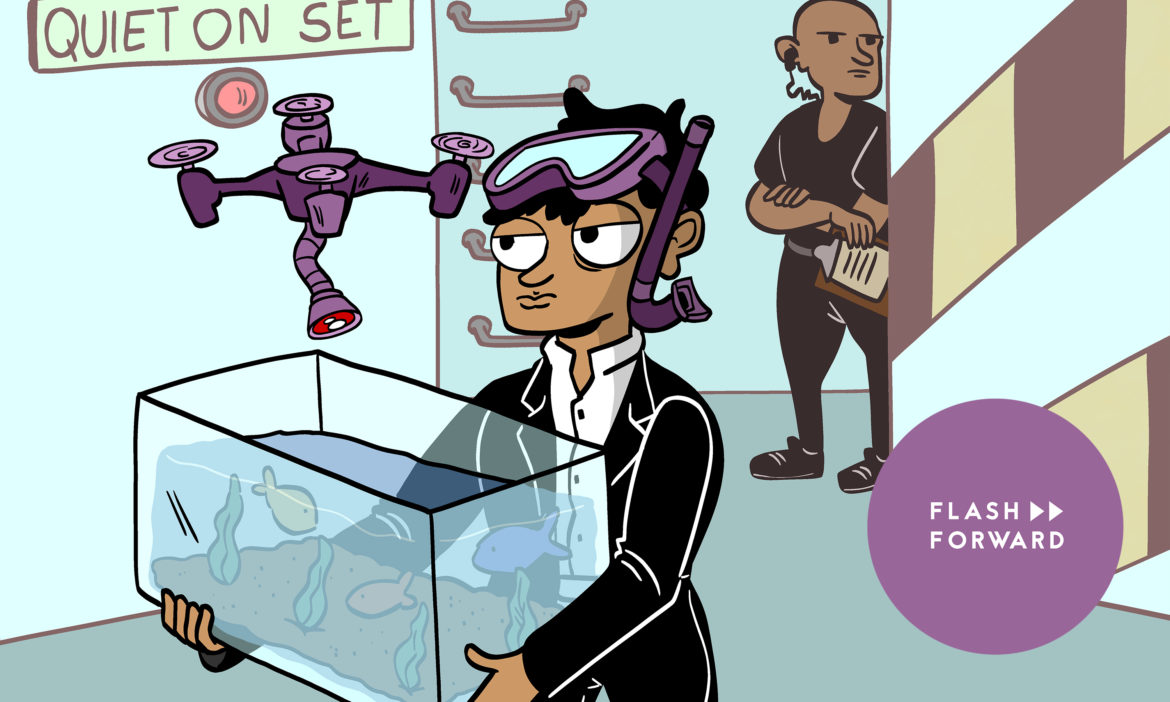

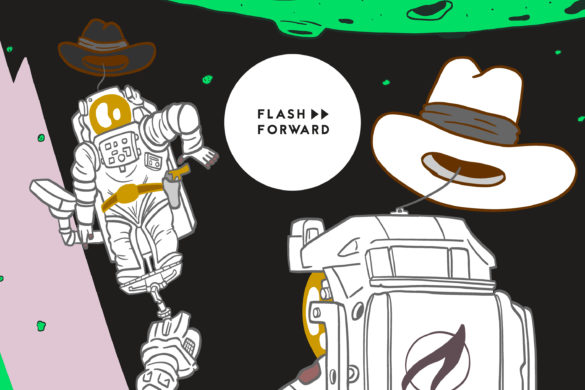
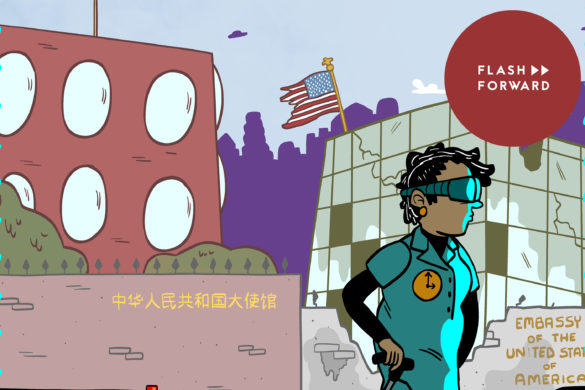
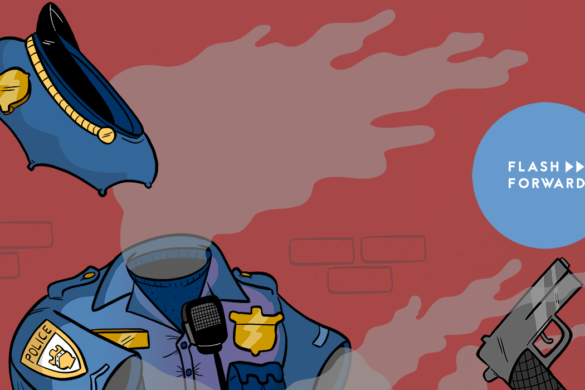
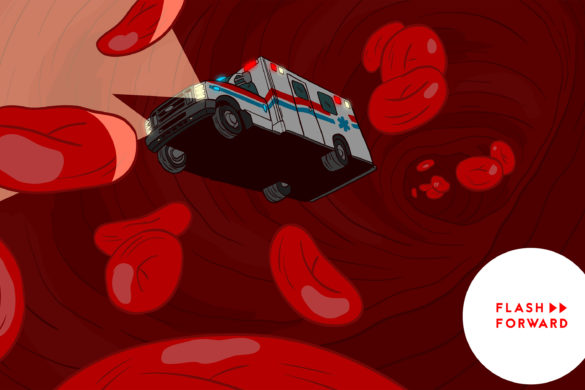
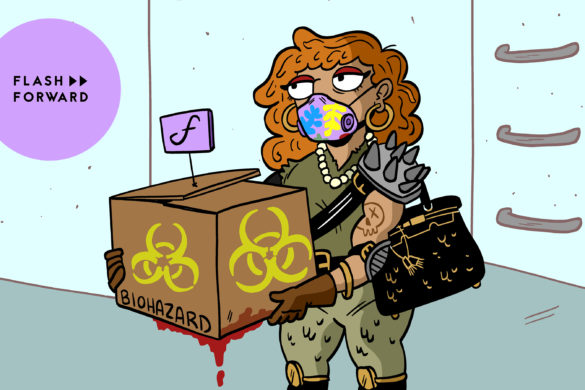
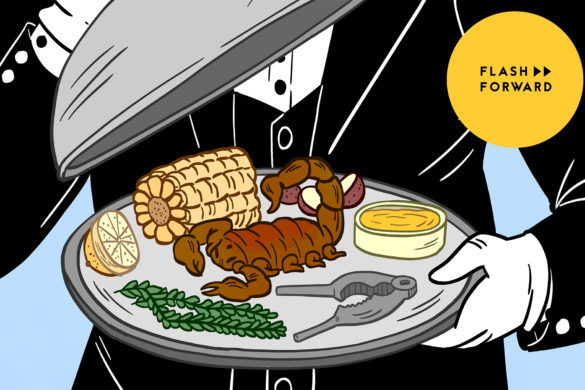
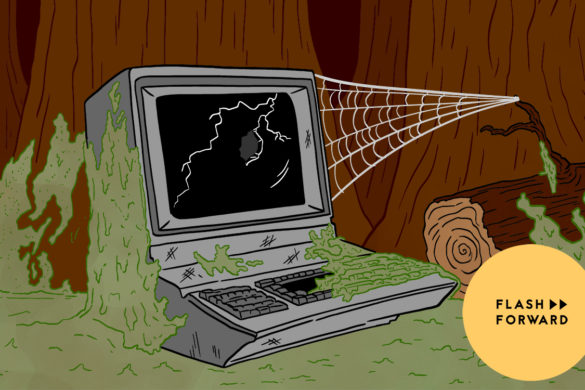
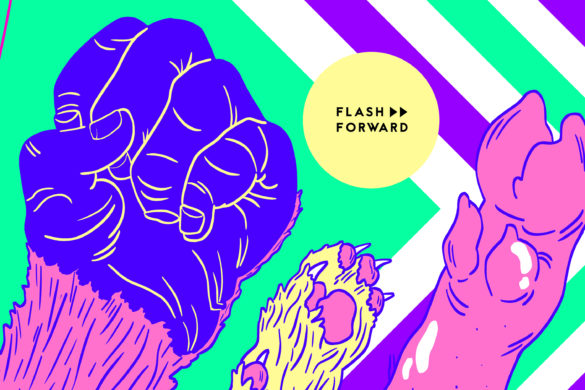
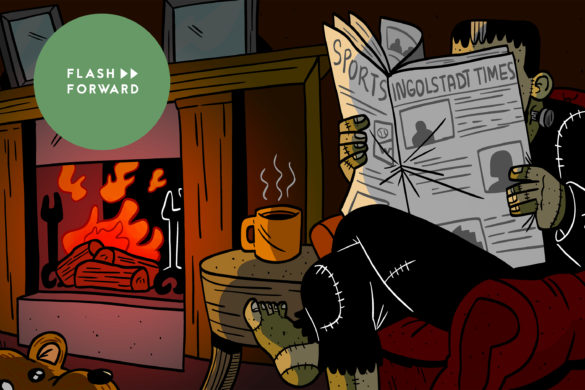
1 comment
[…] EARTH: The Ocean Farm […]